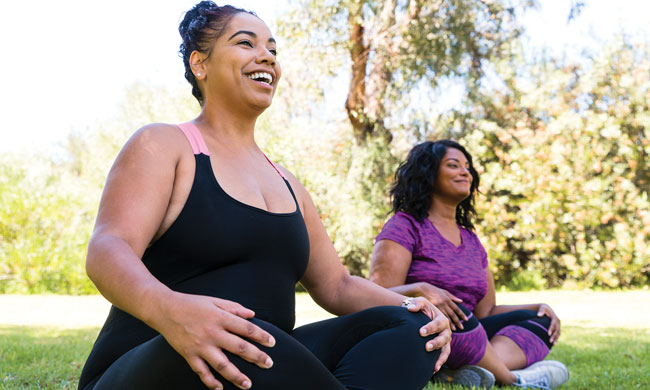Menopause, perimenopause, endometriosis, and polycystic ovaries are all recognised as “women’s health issues” in the healthcare world. For the millions of women suffering from these conditions, it can be a life-changing, debilitating, daily challenge. The Women’s Health Strategy for England Report, published in July 2022, acknowledged that the health of women and girls over the course of their lives has long been neglected*.
‘Although women in the UK on average live longer than men, women spend a significantly greater proportion of their lives in ill health and disability when compared with men. Not enough focus is placed on women-specific issues like miscarriage or menopause, and women are under-represented when it comes to important clinical trials. This has meant that not enough is known about conditions that only affect women, or about how conditions that affect both men and women impact them in different ways.’ – extract from The Women’s Health Strategy for England Report, published in July 2022
Menopause was cited as the third biggest concern for women in the report, which made a commitment to ensuring healthcare professionals in primary care are well informed about the menopause, and able to offer women evidence-based advice and treatment options, including HRT and alternatives – in the next 10 years. One year later, we see constant headlines about supply issues around HRT – a situation that according to one 52-year-old woman we spoke to in Kent, UK, shows no signs of improving. She hasn’t been able to source HRT for three months now and it is impacting her daily life and wellbeing.
Low-dose naltrexone (LDN) is being prescribed by some pharmacists and medical professionals, particularly in the United States, to help with symptoms such as memory loss, brain fog and mood swings. It helps by boosting natural endorphins, which the body produces to relieve pain and stress. However, it remains under-funded and under-supported, despite its potential to help so many women.
In the UK, there is a charity called The LDN Research Trust, which was created by Linda Elsegood after discovering LDN for treatment of her severe MS symptoms. She now runs the charity, and has just returned from hosting the 9th LDN Conference in America, something she would never have dreamed of doing before taking LDN when her MS was so severe she relied on a wheelchair to get around outside of the house.
What is LDN? https://ldnresearchtrust.org/what-is-low-dose-naltrexone-ldn
Low-dose naltrexone reduces pain and fights inflammation. It is used to treat cancers, mental health issues, autoimmune diseases, chronic pain and lots more. Research into the effects of LDN began in the 1980s by Dr Ian Zagan and Dr Patrician McLachlan at Penn State. The first published human trial was in 2007 by Dr Jill Smith – a study for Crohn’s disease. The primary aim of The LDN Research Trust is to initiate clinical trials of LDN. While raising funds for trials, the Trust has helped 100,000+ people obtain LDN from a GP or consultant, either through the NHS or private prescription. They work internationally and report that the use of LDN is spreading. The ultimate goal is for there to be greater awareness of, and access to, LDN for a wide range of conditions.
“Low dose naltrexone has been shown repeatedly to be safe and effective for patients battling health conditions with inflammatory components, including PCOS and endometriosis. As we are looking to expand our treatment options in the field of women’s health care, further research involving low dose naltrexone could lead to exciting possibilities.” – Olga L. Cortez, MD, OBGYN, contributor to The LDN Book 2.
“I think it would benefit the government to explore the potential benefits of LDN as a treatment option for women’s health issues. LDN is known to be a safe, non-toxic, inexpensive drug. Utilising LDN could help millions of women in the UK improve their quality of life. Additionally, implementing LDN as a treatment option could save the government millions of pounds in the long run.” – Linda Elsegood, The LDN Research Trust Founder
“As low dose naltrexone finds its place among other therapies in the treatment of autoimmune disorders, it has now also made a contribution to women’s health. A worthy question, then, is, “If you have a medication that reverses autoimmune disorders and decreases inflammation in chronic infections, how can this be translated to the treatment of pelvic problems that are not autoimmune in nature?” The two diagnoses of endometriosis and polycystic ovarian syndrome have now been shown to have an inflammatory component. Seen in this light, these conditions can understandably be treated with LDN as an adjunct to traditional therapies.” – Olga L. Cortez, MD, OBGYN, contributor to The LDN Book 2.
Case study (taken from The LDN Book 2)
The patient is a 36-year-old Caucasian female with two prior pregnancies and deliveries. She presented with a long-standing history of endometriosis. She had a Mirena IUD placed in 2010, after the birth of her last child. This worked well for pain management at that time. Her Mirena IUD was replaced with a new Mirena in 2015.
The patient presented in early 2018 with severe abdominal pain and abdominal bloating that only occurred on the 10th/11th of every month and again on the 23rd/24th of every month. She had no periods, as would be expected with a Mirena IUD. She had nightly nausea and emesis during her pain episodes. Three different gastroenterologists had seen the patient. She underwent an endoscopy and colonoscopy, both of which were normal. She then underwent a cholecystectomy, which was uneventful. She was told that her pain was possibly the result of IBS, but none of the medications prescribed by her gastroenterologist helped. Given the cyclic nature of her pain, we determined it could be the result of her endometriosis and her Mirena IUD was replaced for the second time.
At her two-month follow-up, the patient reported that the intensity of the pain had lessened but not completely resolved. The patient was then offered low dose naltrexone. We began at 1mg once daily, increasing her daily dose each week by 1mg. When she reached 4.5mg per day, the patient did not have a resolution of her pelvic pain. We therefore instructed her to continue increasing her dose weekly until she reached 9mg daily.
After three months on low dose naltrexone, the patient is now pain-free. Her GI symptoms have also resolved.





